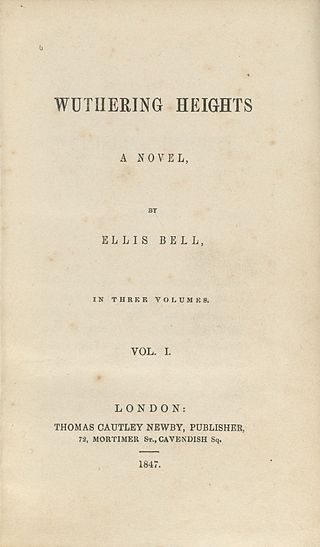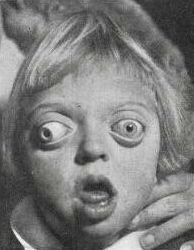
Lord Voldemort is a fictional character and the main antagonist in the Harry Potter series of novels by J. K. Rowling. He first appears in Harry Potter and the Philosopher's Stone (1997) and returns either in person or in flashbacks in each novel in the series except the third, Harry Potter and the Prisoner of Azkaban, in which he is only mentioned.

Wuthering Heights is the only novel by the English author Emily Brontë, initially published in 1847 under her pen name "Ellis Bell". It concerns two families of the landed gentry living on the West Yorkshire moors, the Earnshaws and the Lintons, and their turbulent relationships with the Earnshaws' foster son, Heathcliff. The novel was influenced by Romanticism and Gothic fiction.

A smile is a facial expression formed primarily by flexing the muscles at the sides of the mouth. Some smiles include a contraction of the muscles at the corner of the eyes, an action known as a Duchenne smile. Among humans, a smile expresses delight, sociability, happiness, joy, or amusement. It is distinct from a similar but usually involuntary expression of anxiety known as a grimace. Although cross-cultural studies have shown that smiling is a means of communication throughout the world, there are large differences among different cultures, religions, and societies, with some using smiles to convey confusion, embarrassment or awkwardness.
A facial expression is one or more motions or positions of the muscles beneath the skin of the face. These movements convey the emotional state of an individual to observers. Facial expressions are a form of nonverbal communication. They are a primary means of conveying social information between humans, but they also occur in most other mammals and some other animal species.
Dahlia Travers is a recurring fictional character in the Jeeves stories of English comic writer P. G. Wodehouse, being best known as Bertie Wooster's bonhomous, red-faced Aunt Dahlia. She is much beloved by her nephew, in contrast with her sister, Bertie's Aunt Agatha.

A microexpression is a facial expression that only lasts for a short moment. It is the innate result of a voluntary and an involuntary emotional response occurring simultaneously and conflicting with one another, and occurs when the amygdala responds appropriately to the stimuli that the individual experiences and the individual wishes to conceal this specific emotion. This results in the individual very briefly displaying their true emotions followed by a false emotional reaction.

Guillaume-Benjamin-Amand Duchenne was a French neurologist who revived Luigi Galvani's research and greatly advanced the science of electrophysiology. The era of modern neurology developed from Duchenne's understanding of neural pathways and his diagnostic innovations including deep tissue biopsy, nerve conduction tests (NCS), and clinical photography. This extraordinary range of activities was achieved against the background of a troubled personal life and a generally indifferent medical and scientific establishment.

In colloquial usage, contempt usually refers to either the act of despising, or having a general lack of respect for something. This set of emotions generally produces maladaptive behaviour. Other authors define contempt as a negative emotion rather than the constellation of mentality and feelings that produce an attitude. Paul Ekman categorises contempt as the seventh basic emotion, along with anger, disgust, fear, happiness, sadness and surprise. Robert C. Solomon places contempt on the same emotional continuum as resentment and anger, and he argues that the differences between the three are that resentment is anger directed towards a higher-status individual; anger is directed towards an equal-status individual; and contempt is anger directed towards a lower-status individual.

The Expression of the Emotions in Man and Animals is Charles Darwin's third major work of evolutionary theory, following On the Origin of Species (1859) and The Descent of Man, and Selection in Relation to Sex (1871). Initially intended as a chapter in Descent of Man, Expression grew in length and was published separately in 1872. Darwin explores the biological aspects of emotional behaviour and the animal origins of human characteristics like smiling and frowning, shrugging shoulders, lifting eyebrows in surprise, and baring teeth in an angry sneer.

A frown is a facial expression in which the eyebrows are brought together, and the forehead is wrinkled, usually indicating displeasure, sadness or worry, or less often confusion or concentration. The appearance of a frown varies by culture. An alternative usage in North America is thought of as an expression of the mouth. In those cases when used iconically, as with an emoticon, it is entirely presented by the curve of the lips forming a down-open curve. The mouth expression is also commonly referred to in the colloquial English phrase, especially in the United States, to "turn that frown upside down" which indicates changing from sad to happy.

Emotion is defined as any mental experience with high intensity and high hedonic content. The existence and nature of emotions in non-human animals are believed to be correlated with those of humans and to have evolved from the same mechanisms. Charles Darwin was one of the first scientists to write about the subject, and his observational approach has since developed into a more robust, hypothesis-driven, scientific approach. Cognitive bias tests and learned helplessness models have shown feelings of optimism and pessimism in a wide range of species, including rats, dogs, cats, rhesus macaques, sheep, chicks, starlings, pigs, and honeybees. Jaak Panksepp played a large role in the study of animal emotion, basing his research on the neurological aspect. Mentioning seven core emotional feelings reflected through a variety of neuro-dynamic limbic emotional action systems, including seeking, fear, rage, lust, care, panic and play. Through brain stimulation and pharmacological challenges, such emotional responses can be effectively monitored.

Heathcliff: The Movie is a 1986 animated anthology children's comedy film from DiC Audiovisuel, released by Atlantic Releasing under their Clubhouse Pictures label.

Heathcliff is a fictional character in Emily Brontë's 1847 novel Wuthering Heights. Owing to the novel's enduring fame and popularity, he is often regarded as an archetype of the tortured antihero whose all-consuming rage, jealousy and anger destroy both him and those around him; in short, the Byronic hero.

Intruder is a 1993 Spanish film, written and directed by Vicente Aranda. It stars Victoria Abril, Imanol Arias and Antonio Valero. The film is a psychological thriller about a middle-class woman torn between her love for her spouse and her ill ex-husband, both of them who were her childhood friends. Intruso received five nominations to the Goya Awards in 1994 including Best Picture.
Discrete emotion theory is the claim that there is a small number of core emotions. For example, Silvan Tomkins concluded that there are nine basic affects which correspond with what we come to know as emotions: interest, enjoyment, surprise, distress, fear, anger, shame, dissmell and disgust. More recently, Carroll Izard at the University of Delaware factor analytically delineated 12 discrete emotions labeled: Interest, Joy, Surprise, Sadness, Anger, Disgust, Contempt, Self-Hostility, Fear, Shame, Shyness, and Guilt.

In medical contexts, a facies is a distinctive facial expression or appearance associated with a specific medical condition. The term comes from Latin for "face". As a fifth declension noun, facies can be both singular and plural.

Sarcasm is the caustic use of words, often in a humorous way, to mock someone or something. Sarcasm may employ ambivalence, although it is not necessarily ironic. Most noticeable in spoken word, sarcasm is mainly distinguished by the inflection with which it is spoken or, with an undercurrent of irony, by the extreme disproportion of the comment to the situation, and is largely context-dependent.
The study of the evolution of emotions dates back to the 19th century. Evolution and natural selection has been applied to the study of human communication, mainly by Charles Darwin in his 1872 work, The Expression of the Emotions in Man and Animals. Darwin researched the expression of emotions in an effort to support his materialist theory of unguided evolution. He proposed that much like other traits found in animals, emotions apparently also evolved and were adapted over time. His work looked at not only facial expressions in animals and specifically humans, but attempted to point out parallels between behaviors in humans and other animals.
Mécanisme de la physionomie humaine. ou, Analyse électro-physiologique de l'expression des passions des arts plastiques. is a monograph on the muscles of facial expression, researched and written by Guillaume-Benjamin-Amand Duchenne de Boulogne (1806–75). It first appeared as an abstract published in Archives générales de médecine in 1862 and was then published in three formats: two octavo editions and one quarto edition. The work was an important resource used by Charles Darwin (1809–82) for his own study on the genetics of behaviour, titled The Expression of the Emotions in Man and Animals, and in recent years it has been reclaimed as an important landmark in the history of the photographic arts.
Shuzo Matsunaga is a Japanese engineer best known for translating the Kural into Japanese from its English version.















